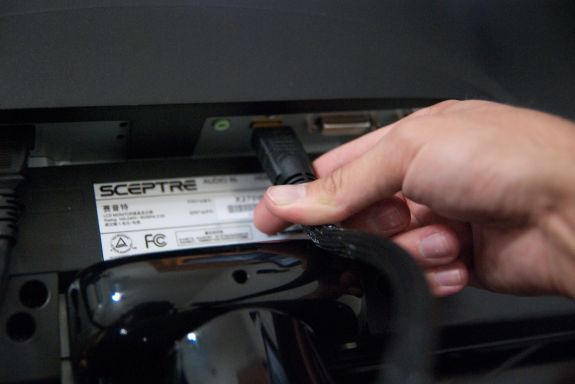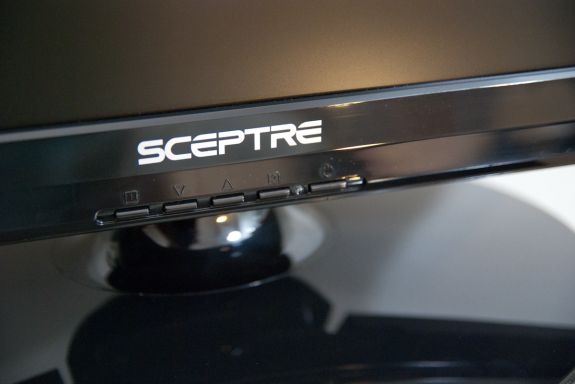Sceptre X270W-1080P Review: A Value 27" That Delivers
by Brian Klug on May 17, 2010 10:22 PM ESTAppearances and Impressions
Out of box, the Sceptre is imposing (though not so much that you’d want to use it as an ornamental staff). That said, there’s no arguing that 27” isn’t monstrous for an LCD display. Packaging is sufficient and of the styrofoam kind - extracting the big panel isn’t a problem, and doesn’t seem to lend itself to being damaged easily.
The display stand is basic - assembly consists of sliding the panel into one piece which then snaps into the circular plastic base. It’s sufficient to hold the display firmly in place, but doesn’t offer any ergonomic options outside of vertical tilt, about 20 degrees is all you get. Keep in mind on a large panel a small amount of tilt feels like a lot because of how much motion there is out at the extreme, but the 20 degrees of travel here lets you get between perfectly vertical, and comfortably tilted upward. There isn’t any height adjustment, swivel, or rotation. The option (tilt) you get is spartan, but the display stand feels firm and works adequately enough that typing on the same desk doesn’t result in some monitor shake starting. That weird kind of monitor tilt resonance can get really annoying, especially on cheaper display stands. There’s a standard 100mm VESA mount, so you can bring your own better stand if you so choose.
Tight Connector Clearance
My only major complaint with the physical design of the Sceptre is that making connectors are given surprisingly little clearance on the back panel. Connecting my relatively chunky dual link DVI cable to the X270W, I had to bend the cable a bit sharply for it to clear the plastic stand. The single link cable supplied in-box has a noticeably smaller connector, so you won’t run into this issue if you use theirs, but be careful if you’ve got some pre-run, fatter DVI-D cables like mine.
Things got a bit worse with the HDMI cables I had on hand, which admittedly have over-engineered cable strain relief and cause all sorts of problems on other displays - these didn’t fit at all and certainly would’ve broken the port inside if I shoved any further. I guess what I’m getting at is that it’d be nice to see a cable management clip or some routing guidance here, and no obstruction preventing you from bringing any cable down and out. At the end of the day, I wound up grabbing some other HDMI cables.
We’ve already talked about the 1080P display resolution and subsequent 16:9 aspect ratio choice. There’s not much to be said other than that 1920x1200 is quickly becoming the exception to the rule, whether you like it or not. For a monitor packing HDMI which will likely be driven at HD resolutions, there’s definitely an argument in favor of 16:9.
The front panel has the OSD controls centered below the Sceptre logo - there are 5 buttons. Four for navigation, one for power. We’ll talk about the OSD menus at the end of the review, but Sceptre’s options are again a bit spartan and just a little confusing - especially for changing volume, but we’ve seen them before.
Power on lag is respectable - from cold boot to 1080P HDMI display in just over 10 seconds. Switching inputs is very fast - nearly instantaneous. The rest of the controls are responsive, though in HDMI mode it does seem like the menus occasionally were a bit slower than over DVI.
Viewing angles are the standard news for a TN panel - very good until you’re viewing the display at an extreme angle. In fact, the only notably bad angle (as with most TNs) is at an extreme negative angle, viewing the monitor from below. Again, that’s to be expected.
All important display quality isn’t perfect out of box, but gets surprisingly good after you calibrate and tune the display’s somewhat outmoded OSD. We did discover one unobtrusive dead pixel, though it seems to come in and out of being a problem.
Overall first impressions are pretty good: The X270W does what it’s supposed to do, and as we’ll see later, does a relatively good job tracking colors and being uniform. It’s a mammoth display, but again dot pitch is a bit bigger than we’re used to.



















61 Comments
View All Comments
GuinnessKMF - Monday, May 17, 2010 - link
Dead pixels are funny beasts, I've actually raised a few from the dead by simply rubbing them (more often these are 'stuck' pixels, as truly dead pixels are well... dead). If it's going in and out, then it's likely revivable, there are also applications you can use that flash a small square of colors in the area of the pixel, sort of waking it up by having the pixels around it all doing the same thing, don't ask me how, but it does work (maybe it's the power of believing).I have had a handful of Sceptres, and I have never been disappointed, the OSD has always been a bit sparse as you said, but once I get them setup I don't find myself worrying about it, and in the realm of gaming/office work they've been fantastic for their size and price.
juzz86 - Monday, May 17, 2010 - link
I agree 100%. My first LCD was a CMV CT-722 and it lasted about two years with no 'dead' pixels. Then all of a sudden three popped up. A bit of massaging later, and all but one had disappeared, and the one that was left was much less noticeable. My Dell 2408WFP had a dead 'line' down one side about half an inch thick, which disappears after the panel warms up. Strange, but I wholly recommend giving them a rub when they appear, assuming you are out of pixel policy warranty of course!Devo2007 - Monday, May 17, 2010 - link
My Dell 2408WFP developed that same issue about 2 years after I purchased it - a thin blue vertical line towards the right side of the display. Like your display, it would go away after the monitor warmed up.Dell did replace the LCD, so hopefully this one doesn't do the same thing.
juzz86 - Tuesday, May 18, 2010 - link
Yeah crazy hey. I still have this monitor hooked up, it's ridiculous now. There's the single-pixel blue line, then a black bar about twenty pixels wide, then a single pink and a single green. And it all just goes away! Random :)Brian Klug - Tuesday, May 18, 2010 - link
Yeah, I know about the eraser head method and pressing lightly on the dead pixels - I've definitely revived a few in the past. This one seems a bit more stubborn though. it's not really visible unless you move to something entirely homogeneous. I never noticed it while playing games or working, only when I was viewing a webpage or something with a solid one color background. Just one pixel though, which isn't that bad.Awesome tips!
-Brian
Pirks - Monday, May 17, 2010 - link
you'd better get this: http://www.newegg.com/Product/Product.aspx?Item=N8...cheaper AND better
kmmatney - Monday, May 17, 2010 - link
I had that Hanns-G LCD (well, I think the previous revision) and it was pretty bad. The contrast was awful, and I found it to be totally unusable for dark scenes. It was fine for work, at least for 6 months, but even then the light bleed got to me. I ended up selling it and getting a smaller, but better monitor, and I'm much more productive and my eyes thank me. I never used it for gaming much, because of the poor performance in low light scenes.araczynski - Wednesday, May 19, 2010 - link
my Hanns-G 28" (27?) has been nothing short of great.Basilisk - Tuesday, May 18, 2010 - link
I agree that the Hanns-G is a great monitor, and slightly less expensive. I've loved mine for about three years. It's worth comparing the two:http://www.newegg.com/Product/Productcompare.aspx?...
I particularly prefer the 3 yr warranty of the Hanns-G; the single year on Sceptre products means I won't be buying them again -- I had to RMA one at 11.5 months!
GoodRevrnd - Monday, May 17, 2010 - link
*cough* Dell U2311h review *cough*